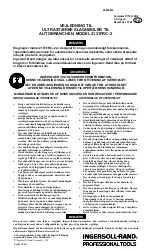
32
MAINTENANCE SECTION
2.
Apply a heavy coat of Ingersoll–Rand No. 105–1LB
Grease or Ingersoll–Rand No. 105–8LB Grease to the
jaws of the Anvil (8).
3.
Replace the Hammers in the Hammer Frame (12)
exactly as they were when you marked them prior to
disassembly.
If you are installing new Hammers or want to
change the location of the existing Hammers to
utilize both impacting surfaces, slide the Hammers
in the Hammer Frame so that the half–round notch
on one Hammer is located on one side of the Frame
and the half–round notch on the other Hammer is
located on the other side of the Frame.
4.
Replace the Hammer Pins (13).
5.
Examine the base of the Anvil (8) and note its
contour. While looking down through the Hammer
Frame, swing the top Hammer to its full extreme one
way or another until you can match the contour of the
Anvil. Enter the Anvil into the Hammer Frame and
through the first Hammer. Swing the bottom Hammer
in the opposite direction from the top Hammer and
maneuver the Anvil slightly until it drops into the
bottom Hammer. Refer to Dwg. TPD1535.
Assembly of the Air Wrench
1.
Position the Motor Housing (19) in leather–covered
vise jaws with the splined shaft of the Rotor in a
horizontal position.
2.
Place the assembled impact mechanism down onto
the splined hub of the Rotor.
3.
Position the Hammer Case Gasket (18) against the
face of the Motor Housing.
Be sure that the flat on the bottom of the Hammer
Case Gasket is installed in the corresponding flat in
the Housing. If the Hammer Case Gasket is not
installed correctly, the Air Wrench will not
function properly.
Refer to Dwg. TPD1335–1.
4.
Apply a thin film of Ingersoll–Rand No. 105–1LB
Grease or Ingersoll–Rand 105–8LB Grease on inside
surface of the Hammer Case Bushing (16), and place
the Hammer Case (15) down over the Anvil and
against the Motor Housing.
FRONT OF
HOUSING
GASKET
FLATS
(Dwg. TPD1335–1)
5.
Install the Hammer Case Screws (11) and tighten
them to 25 in–lb (2.8 Nm) torque.












































